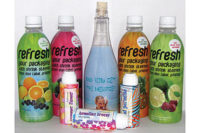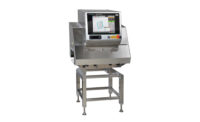

Jim Dwyer, president and CEO, The RB Dwyer Group, Melville, N.Y.
Don Earl, owner, Overnight Labels, Deer Park, N.Y.
Drew Faust and John O’Donnell, sales, EPI Labelers, New Freedom, Pa.
Ron Giordano, chairman and CEO, H.S.Crocker Co., Huntley, Ill.
Stacy Santos, marketing manager, Dion Label Printing, Westfield, Mass.
The talk in the dairy processing world is about “sustainability,” “food safety” and “nutrition.” These terms resonate with the general public. Marketers use packaging and labeling to convey these concepts to shoppers.
A new, voluntary U.S. Department of Agriculture initiative identifies bio-based products (those whose main ingredients are renewable plant or animal materials). The USDA says the purpose is to more clearly identify bio-based products and to promote their use.
Clear Lam Packaging, Inc., Elk Grove Village, Ill., received a bio-based label for its renewable thermoformed produce packaging made from more than 93% plant-based bioplastics derived from Ingeo PLA (polylactic acid), along with ingredients. Marketers can put a USDA-certified bio-based label on their packaging. Clear Lam submitted additional packaging for the BioPreferred program, including packages for dairy foods such as yogurt and cottage cheese.
Consumer packaged goods (CPG) marketers are including nutrition information (including calories per serving and fiber content) more prominently on their packaging, while grocery retailers are using shelf talkers to convey this information.
Food marketers are taking advantages of new technologies, such as smart phones, to add quick-response codes to packages. This is a way to engage the shopper and to provide additional information about the brand.
This spring, Dairy Foods chief editor Jim Carper convened a virtual roundtable of executives in the labeling field and asked about food safety, package clutter and training. Following is an edited transcript of emailed responses.
Dairy Foods: How has the increase in food safety-related product recalls over the last three years impacted the services you offer or the engineering and design of your equipment?
Jim Dwyer: Every label that we print incorporates nutritional information. In addition, many of our customers like the benefits of a decorative sleeve and tamper-evident band. This all-in-one combination label allows the CPG to bring out a product that looks great and also is secure.
It also eliminates the need for two components, making this a more environmental friendly package. Our tamper-evident bands and preforms - frequently used on ice cream and cultured products - also provide that extra amount of security that consumers are looking for.
John O’Donnell: We have seen an uptick in customers requesting application of [our] barcode labels to packages using a print-and-apply labeler to apply tracking labels to the front or back of packages.
Drew Faust: The print-apply system has led us to engineer more printer applicators for an ever-expanding array of applications, ranging from master cartons to individual packages.
Dairy Foods: What steps has your company taken in reaction to the new Food Safety Modernization Act?
Ron Giordano: We are coordinating with our auditing team to ensure that these new measures are being addressed.
Dwyer: The Food Safety Modernization Act does not directly impact shrink labels because the labels do not come in direct contact with food. However, we do business with many CPGs and they have certain requirements for our facilities. Our facilities have adopted food-safety policies and procedures that incorporate good manufacturing processes so that our facilities pass their inspections.
Dairy Foods: There is a movement among packaged goods companies to add nutritional data to the front of their packages. Other CPGs are adding mobile tags (QR or quick-response codes) elsewhere on the package. How do you advise customers to avoid package clutter?
Stacy Santos: Requests for QR codes are increasing. A QR code can be printed on various substrates, so it does not matter whether it’s printed on a film, foil or tag material. The one thing that must happen, as with all barcodes, is that the QR code must be on a white background to yield the best scan results.
Since QR codes can carry information both horizontally and vertically, a QR code is able to encode the same amount of data in approximately one-tenth the space of a traditional barcode. Most label designs that we see in the dairy industry are one to three colors. However, recently, we are seeing a shift to more companies using shrink sleeves in their packaging and four-color process labels. There hasn’t been a problem incorporating QR codes into the label because they can be so small. There is most always white space available on current dairy label designs. A food manufacturer does not have to give up something (product benefits, etc.) in return for a QR code.
QR codes can be in four color, not just black and white. If you research “QR codes color,” you will see some fascinating, colorful codes and some embedded images, such as a company logo, giving them a cool design effect.
Faust: We can offer the customer the option of applying pre-printed labels or printing variable nutritional information on a label and applying it to either the front or back of a package that is produced on vertical or horizontal form/fill/seal equipment. This creates the flexibility to apply a label rather than printing the information on the film, allowing the information to easily be changed without creating unusable packaging film that has been printed with outdated information.
Additionally, we have several customers that get labels pre-printed with their multicolored logo and we add the variable information to it, giving them total flexibility. Simply put, it adds flexibility and reduces waste.
Don Earl: If it’s a beverage or some other product that comes in a container, they may be able to use shrink sleeves. Shrink sleeves conform to the whole container and give more real estate for additional reporting information required by the USDA or FDA. A sleeve gives you 360-degree graphics and potential tamper evidence, much more than a pressure-sensitive (PS) label does.
When a PS label is required, we can supply the customer with a peel-back label. This structure allows us to print on the front of the label, and then print on a portion of the adhesive side, increasing the real estate of a typical label. These labels are generally made out of a film material and offer beautiful graphic appeal and durability.
Dwyer: Our shrink labels offer a 360-degree image area. Therefore, there is enough room for graphics, nutritional information and anything else they might want the consumer to know about their product. Designing graphics for shrink labels enables the CPGs plenty of room for data.
Dairy Foods: How do you ensure adequate operator and maintenance personnel training as your equipment or systems continue to advance, both mechanically and electronically?
Faust: We have always worked very hard to keep the operators and maintenance personnel front and center as our equipment continues to advance. We believe that our equipment should be easy to use as well as maintain.
We also take what are sometimes painstaking steps to design simplicity into the equipment from the beginning of the design phase. The end result is a system that is easy to learn. Therefore, training is simplified and more than adequate. If technology is used correctly, it does not add complexity. In fact, it can be used to your advantage and remove complexity.
O’Donnell: We have always stayed true to the opinion that, for operators, any mechanical adjustment or HMI adjustment should remain easy to understand. We also lock out any function in the HMI or PLC that is not critical to the day-to-day operation of the equipment. The adjustment of variable information within the PLC or HMI can be accessed using a security code that is typically given to one senior member of the maintenance staff.
As for maintenance training, we employ the techniques learned through the PMMI Certified Training program that all of our techs have been schooled in.
Giordano: Our continuous training programs as specified in our standard operating procedure program are being updated, and training is ongoing throughout the year. It is a never-ending program that keeps all personnel in the plant attending training all year.
Codes on Caps, Sleeves Keep Track of SKUs
Byrne Dairy’s Ultra Dairy unit produces aseptic milk and dairy products in a 40,000-square-foot facility in East Syracuse, N.Y. Clear, crisp codes are important to Ultra Dairy because the codes are used to meet government and customer requirements for supply chain traceability. In addition, some of Ultra Dairy’s customers require barcodes that are scanned for inventory purposes. Finally, end consumers rely on clear expiration dates to ensure they are purchasing and consuming a fresh product.
“It is critical for us that the codes on every package are clear, legible and reliable,” says Eric Greiner, ESL sales manager for Ultra Dairy. “If our customers receive a case with a barcode they can’t scan or a product with a code they can’t read, they’ll send it back.”
For coding on its bottling line, Ultra Dairy uses a small-character ink-jet printer. On one line, Ultra Dairy codes caps on finished products, and on another line, codes sleeves that are wrapped around bottles. The inkjet printers, laser coders and print-and-apply labelers are from Videojet Technologies Inc., Wood Dale, Ill.
The fluid cartridges also include a microchip that verifies whether the correct fluid has been installed. This is extremely helpful for Ultra Dairy because the company must use different inks for the bottle caps and the sleeves, as the sleeves require an ink with a faster drying time. The microchip ensures the fluids for each substrate cannot be mixed up or incorrectly installed.
– Contributed by Sascha Benke, director of vertical marketing, food, Videojet Technologies Inc. Read more about this installation athttp://tinyurl.com/4xbqzg7in the Case Studies section ofDairyFoods.com.

